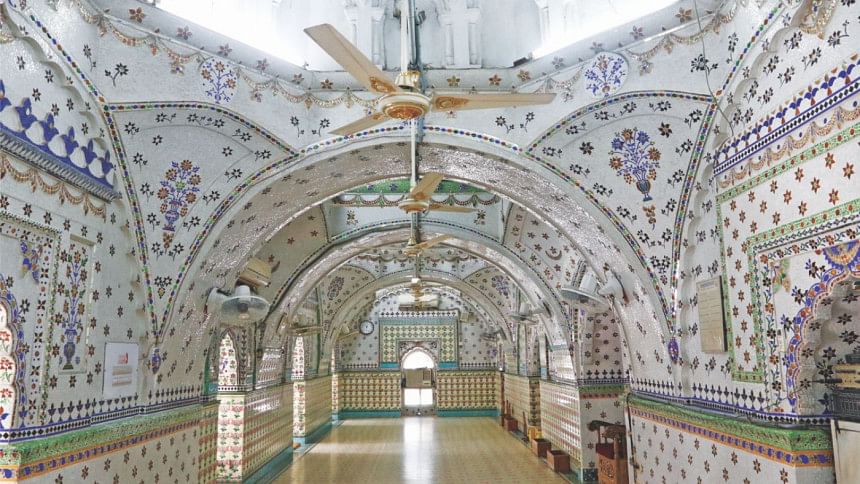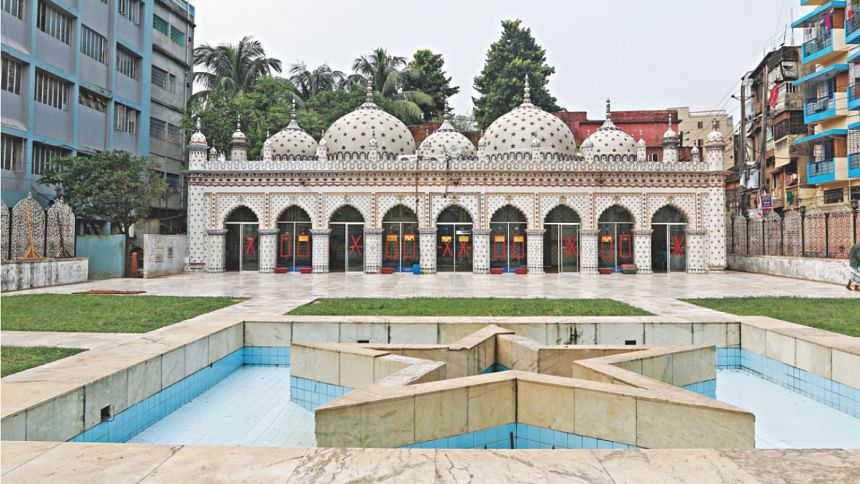The Sparkling Star Mosque

Photo: Prabir Das
Amidst thousands of unappealing, ramshackle buildings in the alleys of Armanitola, one of the oldest and congested parts of Dhaka, an exquisite white marble structure superbly decorated with engraved floral and star patterns will surely capture your attention. Even the local residents of the area often stop for a while to have a look and be amazed with its perpetual beauty.
This superb structure, popularly called Tara Masjid (Tara Mosque), is still standing tall with her dazzling beauty after more than three centuries. This mosque got its name from innumerable star patterns (Tara in Bengali) made of brightly coloured tiles covering the entire polished marble walls of the mosque. There is also a large star shaped fountain and water reservoir for pre-prayer ritual ablution of the Muslims.
The mosque was built by a Mughal landlord named Mirza Gulam Pir. Unlike other Mughal architectures, there is no inscription found in the mosque mentioning its founding year. However, according to the trustees of the mosque, it was built in the year 1711, when Dhaka was under Mughal rule. At that time it was a tiny 3 domed mosque made with marble imported from Rajmahal of India. The length of the building was 10.06 metres and the width was 4.04 metres. The walls were not decorated at that time. Still, a part of the original plainly plastered wall can be found behind the mosque.

In 1926, a wealthy merchant named Ali Jaan Bepari, who was a resident of Armanitola, took the initiative to renovate and redecorate the entire mosque. Enthusiastic Ali imported exquisite, precious china clay tiles from Japan and England. Then, with skilled local artisans, he decorated the entire mosque walls, even the domes, with beautiful floral and star shaped patterns made of the china clay tiles. In the white marble background, the glistening engraved stars and floral patterns create a magical and serene environment of light and shade in the mosque, as they reflect sunlight in different angles. There are also verses from the holy Quran engraved in the interior walls. A courtyard and the star shaped fountain were built at that time in the eastern side of the mosque. These additional structures were paved with marbles of the same quality used in building the mosque.
Besides beautifying the mosque, this pious and benevolent merchant also built a residential religious school where students are still taught from Islamic religious texts, completely free of cost. During this massive renovation, Ali Jan Bepari and his artisans carefully preserved the original structural design of the mosque and only beautified the existing structure. However, in 1987, in the name of beautification of this archaeological site, the then government's archaeological department extended the prayer hall and included two more domes, damaging its original historic structure.
Tara Mosque is one of the few pieces of architecture in this sub continent which has such elaborate special type of china clay mosaic works, traditionally called Chini Tikri. Currently, this art and its specialist artisans have gone extinct from our country. Still local residents offer prayers regularly in this beautiful mosque. However, local residents apprehend that this mosque may face further destruction, in the name of renovation and modernisation. The concerned authority must take proper steps to preserve this historic and beautiful archaeological site.

 For all latest news, follow The Daily Star's Google News channel.
For all latest news, follow The Daily Star's Google News channel. 



Comments